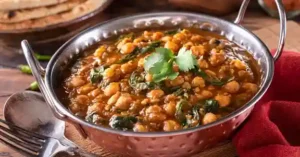
Introduction to Spinach Potato Curry (Aloo Palak)
Spinach Potato Curry, also known as Aloo Palak, is a classic dish cherished for its simple yet flavorful combination of tender potatoes and vibrant spinach. This nutritious and satisfying curry is a staple in many households, celebrated for its ease of preparation and rich taste. Whether you’re new to cooking or an experienced chef, this dish offers a delightful way to enjoy the wholesome goodness of vegetables and spices. Join us as we explore how to make this delicious and versatile curry, perfect for any meal.
Spinach Potato Curry, or Aloo Palak, is a beloved dish in South Asian cuisine, particularly in Indian and Pakistani households. This dish harmoniously blends the earthy flavors of spinach with the soft, starchy goodness of potatoes, creating a comforting and flavorful meal. Aloo Palak is not just popular for its taste but also for its nutritional benefits, making it a healthy choice for vegetarians and those looking to incorporate more greens into their diet.
The origins of Aloo Palak are rooted in traditional Indian cooking, where leafy greens and tubers have long been staple ingredients. Spinach, known as “palak” in Hindi, is rich in iron, vitamins, and antioxidants, making it a vital component of a balanced diet. Potatoes, or “aloo,” provide a satisfying and filling base that complements the spinach perfectly. The dish is usually seasoned with a blend of spices such as cumin, turmeric, and garam masala, which add depth and warmth to the flavor profile.
Aloo Palak is incredibly versatile and can be adapted to suit various dietary preferences and taste profiles. Some versions are creamy, with the spinach pureed into a smooth sauce, while others keep the leaves intact for a more rustic texture. It’s commonly enjoyed with rice, roti, or naan, making it a versatile addition to any meal.
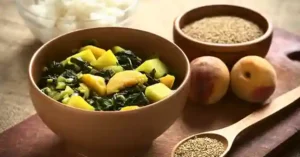
Ingredients Overview
The foundation of a great Spinach Potato Curry lies in its carefully selected ingredients, which come together to create a flavorful and nutritious dish. Here’s an overview of the key components and their roles in the recipe:
Primary Ingredients:
Spinach (Palak):
- Fresh Spinach: Fresh spinach leaves are preferred for their vibrant color and tender texture. Look for leaves that are bright green and free from wilting or yellowing.
- Frozen Spinach: A convenient alternative, frozen spinach is pre-washed and chopped, making preparation easier. It’s a great option when fresh spinach is not available.
Potatoes (Aloo):
- Type: Any variety of potato can be used, but waxy potatoes like Yukon Gold or red potatoes hold their shape better during cooking. Russet potatoes, while softer, can still be used if you prefer a slightly creamy texture.
- Preparation: Potatoes should be peeled and diced into uniform cubes to ensure even cooking.
Optional Ingredients and Variations:
- Tomatoes: Fresh or canned tomatoes add acidity and sweetness, balancing the earthy flavors of spinach and potatoes.
- Onions: Finely chopped onions provide a sweet and savory base for the curry, enhancing the overall flavor.
- Garlic and Ginger: These aromatics are essential for adding depth and warmth. Freshly minced garlic and grated ginger are commonly used.
- Green Chilies: For a touch of heat, green chilies can be added. Adjust the quantity based on your spice tolerance.
- Paneer or Tofu: For a protein boost, cubes of paneer (Indian cottage cheese) or tofu can be incorporated, making the dish more filling.
Spices and Seasonings:
- Cumin Seeds: Often used in the tempering process to infuse the oil with a warm, nutty flavor.
- Turmeric Powder: Adds a golden color and subtle earthy flavor.
- Coriander Powder: Enhances the dish with its citrusy, floral notes.
- Garam Masala: A blend of ground spices, garam masala adds complexity and a hint of sweetness.
- Salt: Essential for seasoning and balancing the flavors.
Optional Additions:
- Cream or Yogurt: For a creamier texture, a splash of cream or a dollop of yogurt can be stirred in towards the end of cooking.
- Lemon Juice: A squeeze of lemon juice brightens the flavors and adds a refreshing tang.
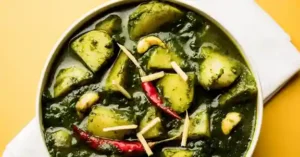
Preparation of Ingredients
Proper preparation of ingredients is crucial for making a delicious and well-balanced Spinach Potato Curry. Here’s a detailed guide on how to prepare each component to ensure the best results:
Spinach (Palak)
Washing:
- Fresh Spinach: Start by thoroughly washing the spinach leaves under cold running water to remove any dirt or grit. If the leaves are particularly muddy, you may need to soak them in water for a few minutes, then rinse again.
- Frozen Spinach: If using frozen spinach, ensure it is fully thawed. You can do this by leaving it in the refrigerator overnight or using a microwave. Once thawed, squeeze out excess water to prevent the curry from becoming too watery.
Chopping:
- Fresh Spinach: After washing, roughly chop the spinach leaves. The size can vary based on preference; some prefer finely chopped leaves for a smoother curry, while others like larger pieces for a more rustic texture.
- Frozen Spinach: Typically comes pre-chopped, so further chopping is usually not necessary.
Potatoes (Aloo)
Selecting and Washing:
Choose potatoes that are firm and free from blemishes. Waxy potatoes like Yukon Gold or red potatoes are ideal as they hold their shape well during cooking. Wash the potatoes thoroughly to remove any dirt.
Peeling and Dicing:
Peel the potatoes using a vegetable peeler. If you prefer to retain the skins for added texture and nutrients, ensure they are well-scrubbed. Dice the potatoes into uniform cubes, about 1-inch in size. Uniformity is key to ensure even cooking.
Aromatics and Flavor Enhancers
Onions:
Peel and finely chop the onions. A fine chop ensures that the onions blend well into the curry, releasing their sweetness and enhancing the flavor.
Garlic and Ginger:
Peel and mince the garlic cloves. For a smoother texture, you can also grate the garlic.
Peel a piece of fresh ginger, then grate or mince it finely. The amount of garlic and ginger can be adjusted according to taste.
Tomatoes (Optional):
If using fresh tomatoes, wash and dice them. For a smoother sauce, you can also blend the tomatoes into a puree.
Canned tomatoes can be used as a convenient alternative; simply crush them before adding to the dish.
Green Chilies (Optional):
Wash the green chilies and slit them lengthwise. The number of chilies can be adjusted based on your preferred level of heat. Removing the seeds can reduce the spiciness.
Spices
Whole Spices:
Measure out the cumin seeds and other whole spices, if using, for tempering. Whole spices are typically added at the beginning to infuse the oil with their flavors.
Ground Spices:
Measure and mix the ground spices, such as turmeric, coriander powder, and garam masala, in a small bowl for easy addition during cooking.
Final Preparations
Cream or Yogurt (Optional):
If adding cream or yogurt for a richer texture, have it ready to stir in towards the end of cooking. Ensure the cream or yogurt is at room temperature to prevent curdling.
Lemon Juice (Optional):
Have a lemon ready to squeeze fresh juice over the finished dish for a burst of acidity and freshness.
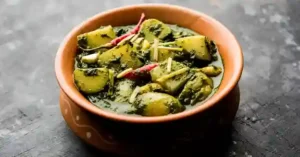
Cooking Instructions
Creating a flavorful and satisfying Spinach Potato Curry involves a series of steps that bring out the best in each ingredient. Follow this detailed guide to ensure a delicious and perfectly cooked dish.
Tempering the Spices
Heat Oil:
Begin by heating a few tablespoons of oil in a large skillet or pan over medium heat. Vegetable oil, ghee, or coconut oil are common choices.
Add Cumin Seeds:
Once the oil is hot, add cumin seeds and let them sizzle and turn fragrant. This process releases the essential oils in the cumin, enhancing the overall flavor of the dish.
Sautéing Aromatics
Add Onions:
Add finely chopped onions to the pan. Sauté until they become soft and golden brown. This step is crucial as it adds depth and sweetness to the curry.
Incorporate Garlic and Ginger:
Add the minced garlic and ginger, stirring frequently to prevent burning. Cook until the raw smell of garlic and ginger dissipates, and they are well integrated into the onion mixture.
Cooking the Base
Add Tomatoes (Optional):
If using tomatoes, add them now. Cook until they break down and blend into the mixture, forming a thick paste. This adds acidity and richness to the curry.
Spice Blend:
Add ground spices, including turmeric, coriander powder, and optionally, a bit of chili powder for heat. Stir well to coat the onions and tomatoes with the spices, cooking for an additional minute to let the spices bloom.
Cooking the Potatoes
- Add Potatoes: Stir in the diced potatoes, ensuring they are well coated with the spice and onion mixture.
- Cooking Liquid: Add water or vegetable broth to cover the potatoes. The liquid will help cook the potatoes and create the curry sauce. The amount of liquid can be adjusted based on your desired consistency.
- Simmer: Bring the mixture to a boil, then reduce the heat and cover the pan. Let it simmer until the potatoes are tender, usually taking about 15-20 minutes. Stir occasionally to prevent sticking and ensure even cooking.
Incorporating Spinach
Add Spinach:
Once the potatoes are nearly cooked, add the chopped spinach to the pan. If using fresh spinach, you may need to do this in batches, allowing the first batch to wilt before adding more.
Cook Spinach:
Stir well to combine. Fresh spinach will wilt quickly and blend into the curry, taking just a few minutes. If using frozen spinach, ensure it is fully integrated and warmed through.
Final Seasoning and Adjustments
Check Seasoning:
Taste the curry and adjust the seasoning with salt and additional spices as needed. This is also the time to add garam masala, which adds a final layer of flavor.
Optional Ingredients:
If desired, stir in a splash of cream or yogurt for a richer texture. If adding yogurt, make sure it’s at room temperature and add it off the heat to prevent curdling.
Finish with Lemon Juice:
A squeeze of fresh lemon juice can brighten the flavors and add a touch of acidity, balancing the richness of the curry.
Serving the Curry
- Garnish (Optional): Garnish with fresh cilantro leaves or a dollop of yogurt for added freshness and contrast.
- Serve Hot: Serve the Spinach Potato Curry hot with rice, roti, naan, or your favorite bread. It’s also delicious with a side of yogurt or pickles for a complete meal.
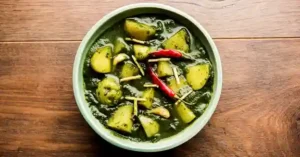
Variations and Customizations
Spinach Potato Curry (Aloo Palak) is a versatile dish that can be adapted to suit various tastes, dietary preferences, and regional influences. Here are some popular variations and customizations to explore, allowing you to tailor the dish to your liking:
Texture Variations
Creamy Aloo Palak:
For a richer and smoother texture, consider blending a portion of the spinach with some of the cooking liquid before adding it back to the curry. This creates a creamy base that coats the potatoes beautifully. Alternatively, adding a splash of heavy cream or a few tablespoons of yogurt at the end of cooking can provide a creamy consistency.
Chunky Aloo Palak:
If you prefer a more rustic and textured curry, leave the spinach leaves whole or roughly chopped. This version highlights the distinct textures of the potatoes and spinach.
Protein Additions
Paneer Aloo Palak:
Adding paneer, a type of Indian cottage cheese, can make the dish more substantial and protein-rich. Cut the paneer into cubes and either pan-fry until golden before adding to the curry, or simply add it directly during the final stages of cooking.
Tofu Aloo Palak:
For a vegan alternative, use firm tofu in place of paneer. Tofu adds a satisfying texture and soaks up the flavors of the curry. Like paneer, tofu can be pan-fried for added texture or added directly to the dish.
Lentils or Chickpeas:
Adding cooked lentils or chickpeas provides additional protein and makes the dish heartier. This is a great way to enhance the nutritional profile of the curry while adding variety.
Spice and Flavor Customizations
Spicier Curry:
Increase the amount of green chilies or add a pinch of cayenne pepper or red chili powder for extra heat. You can also experiment with different types of chili peppers based on your preference for spiciness.
Herb Variations:
Adding fresh herbs like cilantro or mint towards the end of cooking can brighten the flavors and add a fresh, herbal note to the curry.
Nutty and Creamy:
For a richer, more indulgent version, consider blending soaked cashews or almonds with a bit of water to create a creamy paste. Stir this into the curry towards the end of cooking for a nutty, creamy finish.
Regional Variations
Saag Aloo:
A popular variation in Punjabi cuisine, Saag Aloo often includes a mix of greens such as mustard greens, fenugreek leaves, or kale in addition to spinach. This blend of greens adds complexity and depth of flavor.
Palak Aloo with Coconut Milk:
In South Indian and coastal cuisines, coconut milk is sometimes added to the curry, lending a sweet and creamy flavor. This version pairs well with rice and complements the spices beautifully.
Palak Aloo with Fenugreek Leaves (Methi Aloo Palak):
Adding a handful of fresh or dried fenugreek leaves (methi) introduces a slightly bitter, aromatic flavor that complements the spinach and potatoes. This variation is particularly popular in North Indian cuisine.
Dietary Adjustments
Vegan and Gluten-Free:
The base recipe for Aloo Palak is naturally vegan and gluten-free. Ensure that any added ingredients, like yogurt or paneer, are replaced with plant-based alternatives to maintain these dietary considerations.
Low-Oil Option:
To reduce the oil content, consider steaming the spinach separately and using a non-stick pan to minimize the need for oil when sautéing the onions and spices.
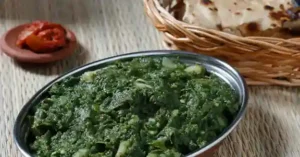
Serving Suggestions
Spinach Potato Curry (Aloo Palak) is a versatile dish that pairs well with various accompaniments, enhancing the dining experience. Here are some serving suggestions to complement and elevate this flavorful curry:
Traditional Accompaniments
Roti or Naan:
Soft, warm roti (Indian flatbread) or naan are classic accompaniments that soak up the flavorful curry sauce. Naan can be plain or flavored with garlic, butter, or herbs.
Rice:
Serve Aloo Palak with a side of steamed basmati rice or jeera rice (cumin-flavored rice). The mild, fluffy rice contrasts nicely with the richly spiced curry.
Paratha:
For a heartier option, pair the curry with paratha, a flaky, layered flatbread. Aloo paratha (stuffed with spiced potatoes) can be an especially delightful match, doubling the potato goodness.
Cooling Side Dishes
Raita:
Raita, a yogurt-based condiment, adds a cooling and refreshing contrast to the spices in the curry. Cucumber raita, boondi raita (with crispy chickpea flour pearls), or mint raita are popular choices.
Plain Yogurt:
A simple bowl of plain yogurt can also serve as a cooling side, helping to balance the heat and richness of the curry.
Additional Toppings and Garnishes
Fresh Herbs:
Garnish the dish with freshly chopped cilantro or mint leaves to add a burst of color and a fresh, herbal note.
Lemon Wedges:
Serve with lemon wedges on the side for guests to squeeze over their servings, adding a bright, citrusy kick that enhances the flavors.
Pickles and Chutneys:
Indian pickles (achar) or chutneys, such as mango chutney or mint chutney, offer an additional layer of flavor and spice, complementing the curry.
Complementary Dishes
Lentil Dishes (Dal):
A serving of dal, such as Dal Tadka or Dal Makhani, provides a protein-rich complement to Aloo Palak. The creamy texture of dal pairs well with the spinach and potato curry.
Vegetable Sides:
Light vegetable sides, such as a simple salad of cucumbers, tomatoes, and onions, or a stir-fried vegetable dish, can add variety and balance to the meal.
Beverages
Lassi:
A glass of lassi, a traditional yogurt-based drink, can be a refreshing accompaniment. Sweet lassi, salted lassi, or mango lassi are popular options.
Chai:
To round out the meal, serve a cup of masala chai (spiced tea). The warming spices in the chai complement the flavors of the curry.
Desserts
Traditional Sweets:
For a complete Indian meal experience, consider finishing with traditional desserts like gulab jamun, rasgulla, or a simple bowl of sweetened yogurt with fruit.
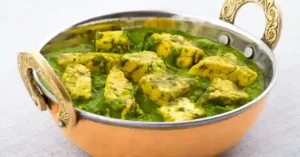
Tips and Tricks for Perfect Spinach Potato Curry
Achieving the perfect Spinach Potato Curry (Aloo Palak) involves more than just following a recipe; it’s about mastering techniques and understanding how to enhance the flavors and textures of the dish. Here are some expert tips and tricks to help you create a delicious and authentic curry every time:
Selecting and Preparing Ingredients
Fresh Ingredients:
Use fresh spinach and potatoes for the best flavor and texture. Fresh spinach has a vibrant green color and tender leaves, while fresh potatoes should be firm and free of blemishes.
Consistent Cutting:
Cut potatoes into evenly sized cubes to ensure they cook uniformly. This prevents some pieces from becoming mushy while others remain undercooked.
Balancing Flavors
Spices:
Use a balanced blend of spices. Cumin seeds and garam masala add warmth and depth, while turmeric and coriander contribute color and earthiness. Adjust the amount of chili powder or green chilies to control the heat level according to your preference.
Salt:
Add salt gradually and taste as you go. Proper seasoning enhances all the flavors in the dish. Remember, it’s easier to add more salt later than to fix an overly salty curry.
Cooking Techniques
Tempering Spices:
Start by tempering whole spices like cumin seeds in hot oil. This step, known as “tadka,” releases the essential oils in the spices, infusing the oil with a robust flavor that forms the base of the curry.
Sautéing Onions:
Sauté onions until golden brown to bring out their sweetness. This process is crucial for developing the base flavor of the curry. Take your time with this step; rushing can result in raw or overly browned onions, affecting the overall taste.
Cooking Tomatoes:
If using tomatoes, cook them until they break down completely. This not only adds acidity to balance the dish but also helps thicken the curry.
Texture Management
Blending Spinach:
For a smoother curry, consider blending some or all of the spinach with a little water or broth before adding it to the dish. This creates a silky texture that evenly coats the potatoes.
Avoid Overcooking:
Be mindful of cooking times to avoid overcooking the potatoes, which can become mushy. The spinach should also be added towards the end to retain its vibrant green color and nutritional value.
Enhancing Richness and Flavor
Cream or Yogurt:
For a richer texture, stir in a small amount of cream or yogurt at the end of cooking. Ensure these ingredients are at room temperature to prevent curdling, and add them off the heat.
Garam Masala and Fresh Herbs:
Add garam masala and fresh cilantro or mint leaves at the end of cooking to preserve their aromatic qualities and enhance the dish’s final flavor.
Adjusting Consistency
Thickening:
If the curry is too watery, let it simmer uncovered to reduce the liquid and concentrate the flavors. Alternatively, mash a few potato pieces into the curry to thicken it naturally.
Thinning:
If the curry is too thick, add a little water, broth, or coconut milk to achieve the desired consistency. Adjust the seasoning accordingly if diluting the flavors.
Storage and Reheating
Storing:
Store leftovers in an airtight container in the refrigerator. The curry can last up to 3-4 days. The flavors often develop and intensify after a day or two, making leftovers even more delicious.
Reheating:
Reheat gently over medium heat, adding a splash of water or broth if needed to loosen the curry. Avoid high heat, as it can cause the spinach to lose its vibrant color and turn a dull green.
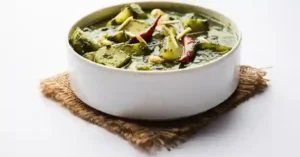
Recipe Notes
When preparing Spinach Potato Curry (Aloo Palak), there are several important notes and tips to keep in mind to ensure the dish turns out perfectly. These insights can help with troubleshooting, ingredient substitutions, and achieving the best results:
Ingredient Substitutions
Spinach:
If fresh spinach is unavailable, use frozen spinach. Ensure it’s thawed and excess moisture is squeezed out before adding it to the curry. For a different green, you can substitute with kale, Swiss chard, or collard greens, though these may alter the flavor and texture slightly.
Potatoes:
While most types of potatoes work, waxy potatoes like Yukon Gold or red potatoes are preferred for their ability to hold their shape. Russet potatoes are softer and can break down more, which is suitable if you prefer a creamier texture.
Paneer:
If you cannot find paneer, tofu or even ricotta cheese can be used as an alternative. For a dairy-free option, use tofu and pan-fry it before adding to the curry.
Adjusting Spice Levels
Heat Levels:
Adjust the amount of green chilies or chili powder based on your heat preference. Start with a smaller amount and increase gradually, tasting as you go to avoid making the curry too spicy.
Spice Blends:
If you do not have garam masala, you can make a quick blend using equal parts cumin, coriander, cinnamon, and cloves. Alternatively, use a store-bought curry powder as a substitute, though it may alter the flavor profile slightly.
Consistency Adjustments
Too Thick:
If the curry is too thick, thin it with a bit of water, vegetable broth, or coconut milk. Stir well and adjust seasoning as needed.
Too Watery:
To thicken a runny curry, simmer it uncovered to allow excess liquid to evaporate. Alternatively, mash some of the potatoes into the curry to naturally thicken it.
Flavor Enhancements
Acidity:
If the curry tastes too rich or heavy, add a squeeze of lemon juice or a splash of vinegar to brighten the flavors and balance the richness.
Sweetness:
For a hint of sweetness, you can add a small amount of sugar or honey. This can help balance the spices and acidity in the curry.
Serving Tips
Resting Time:
Allow the curry to rest for a few minutes after cooking. This lets the flavors meld together and can enhance the overall taste.
Garnishes:
Fresh cilantro or mint leaves added just before serving can provide a burst of fresh flavor. A dollop of yogurt or a drizzle of cream can also add richness and contrast.
Storage and Freezing
Refrigeration:
Store leftover curry in an airtight container in the refrigerator. It will stay fresh for up to 3-4 days.
Freezing:
Spinach Potato Curry can be frozen for up to 2-3 months. Allow it to cool completely before transferring it to a freezer-safe container. Thaw in the refrigerator overnight before reheating.
Reheating Tips
Gentle Reheating:
Reheat the curry over medium heat to avoid burning or overcooking the spinach. Stir occasionally and add a splash of water or broth if the curry has thickened too much during storage.
Microwave:
If using a microwave, reheat in short intervals, stirring in between, to ensure even heating.

What to Serve with Spinach Potato Curry
Spinach Potato Curry (Aloo Palak) is a flavorful and versatile dish that pairs wonderfully with a variety of accompaniments. The right sides can complement the curry’s rich flavors and enhance the overall dining experience. Here are some ideas for what to serve with your curry:
Rice Dishes
Steamed Basmati Rice:
The fluffy texture of basmati rice is perfect for soaking up the curry sauce. Cook the rice with a pinch of salt and a few whole spices like bay leaf and cardamom for added flavor.
Jeera Rice:
Jeera rice, flavored with cumin seeds, adds a subtle spice that pairs well with the curry. Simply sauté cumin seeds in oil before adding the rice and water for cooking.
Pilaf or Pulao:
A vegetable pilaf or pulao, cooked with aromatic spices and mixed vegetables, provides a flavorful base that complements the curry. You can make it with basmati or any long-grain rice.
Indian Breads
Roti (Chapati):
Roti, or chapati, is a whole wheat flatbread that is ideal for scooping up curry. Its slightly chewy texture complements the curry’s flavors.
Naan:
Naan, a soft and pillowy bread, is a favorite accompaniment for curries. Options include plain naan, garlic naan, or butter naan for extra richness.
Paratha:
Paratha, a flaky and layered flatbread, adds a delightful texture. Stuffed varieties, such as aloo paratha (filled with spiced potatoes), can be a hearty option.
Cooling and Refreshing Sides
Raita:
Raita, a yogurt-based side dish, provides a cooling effect that balances the spices in the curry. Options include cucumber raita, boondi raita (with crispy chickpea flour pearls), or a simple yogurt raita.
Plain Yogurt:
A bowl of plain yogurt can also serve as a cooling side. It helps to mellow the spices and adds a creamy contrast to the curry.
Vegetable Sides
Simple Salad:
A fresh salad of cucumbers, tomatoes, onions, and a light dressing of lemon juice and herbs can add a crisp, refreshing element to the meal.
Stir-Fried Vegetables:
Lightly stir-fried vegetables, such as bell peppers, carrots, and peas, can add a colorful and nutritious side that complements the curry.
Pickles and Chutneys
Indian Pickles (Achar):
Spicy and tangy Indian pickles, like mango or lime pickle, add a burst of flavor that enhances the curry. They are especially good for adding a bit of extra spice and tang.
Chutneys:
Chutneys, such as mint chutney or tamarind chutney, provide a sweet and tangy contrast to the curry. They can be used as a dip or a side condiment.
Additional Toppings
Fresh Herbs:
Garnish the curry with freshly chopped cilantro or mint leaves for a burst of fresh flavor and color.
Lemon Wedges:
Serve lemon wedges on the side for guests to squeeze over their curry, adding a fresh, citrusy note.
Beverages
Lassi:
A glass of lassi, a traditional yogurt-based drink, is a refreshing complement. Sweet lassi, salted lassi, or mango lassi are excellent choices.
Masala Chai:
For a warming finish to the meal, masala chai (spiced tea) provides a comforting and aromatic beverage that pairs well with the curry.
Desserts
Traditional Indian Sweets:
Finish the meal with traditional Indian desserts like gulab jamun, rasgulla, or kheer (rice pudding) for a sweet ending.
More Tested & Perfected Vegetarian Curry Recipes
If you enjoy Spinach Potato Curry (Aloo Palak), you might also like exploring other vegetarian curry recipes. Here are some tried-and-tested favorites that offer a variety of flavors, ingredients, and cooking techniques:
Chana Masala (Chickpea Curry)
- Description: Chana Masala is a hearty and protein-rich curry made with chickpeas simmered in a spiced tomato-based sauce. It’s a staple in Indian cuisine and beloved for its robust flavor and satisfying texture.
- Ingredients: Chickpeas, onions, tomatoes, garlic, ginger, cumin seeds, coriander powder, turmeric, garam masala, green chilies, and cilantro.
- Instructions: Sauté onions, garlic, and ginger, then add tomatoes and spices. Stir in cooked chickpeas and simmer until flavors meld. Garnish with fresh cilantro.
Dal Tadka (Spiced Lentils)
- Description: Dal Tadka features cooked lentils flavored with a tempering of spices. It’s both comforting and nutritious, making it a popular choice for a protein-rich vegetarian meal.
- Ingredients: Yellow or red lentils, onions, tomatoes, garlic, ginger, cumin seeds, mustard seeds, turmeric, chili powder, garam masala, and cilantro.
- Instructions: Cook lentils until soft. Prepare a tempering of cumin seeds, mustard seeds, onions, garlic, and spices, then mix with the cooked lentils. Simmer briefly and garnish with cilantro.
Paneer Butter Masala
- Description: Paneer Butter Masala is a creamy, tomato-based curry with paneer (Indian cottage cheese) cubes. It’s rich, indulgent, and often enjoyed with naan or rice.
- Ingredients: Paneer, tomatoes, onions, garlic, ginger, butter, cream, cumin seeds, garam masala, turmeric, chili powder, and cilantro.
- Instructions: Sauté onions, garlic, and ginger, then add tomatoes and spices. Stir in paneer cubes and cream. Simmer until paneer is heated through. Finish with butter and garnish with cilantro.
Aloo Gobi (Potato and Cauliflower Curry)
- Description: Aloo Gobi combines potatoes and cauliflower in a mildly spiced curry. It’s a versatile dish that pairs well with both rice and bread.
- Ingredients: Potatoes, cauliflower, onions, tomatoes, garlic, ginger, cumin seeds, turmeric, coriander powder, chili powder, and cilantro.
- Instructions: Sauté onions, garlic, and ginger, then add tomatoes and spices. Mix in potatoes and cauliflower, cooking until tender. Garnish with cilantro.
Baingan Bharta (Roasted Eggplant Curry)
- Description: Baingan Bharta features roasted and mashed eggplant cooked with onions, tomatoes, and spices. The roasting process adds a smoky flavor to the curry.
- Ingredients: Eggplant, onions, tomatoes, garlic, ginger, cumin seeds, coriander powder, turmeric, garam masala, and cilantro.
- Instructions: Roast eggplant until tender, peel, and mash. Sauté onions, garlic, and ginger, then add tomatoes and spices. Stir in the mashed eggplant and simmer. Garnish with cilantro.
Vegetable Korma
- Description: Vegetable Korma is a rich and creamy curry made with mixed vegetables and a spiced coconut or yogurt sauce. It’s aromatic and mildly spiced, perfect for a special meal.
- Ingredients: Mixed vegetables (e.g., carrots, peas, potatoes), onions, tomatoes, garlic, ginger, coconut, yogurt, cashews, cumin seeds, coriander powder, turmeric, garam masala, and cilantro.
- Instructions: Sauté onions, garlic, and ginger, then add tomatoes and spices. Stir in mixed vegetables and cook until tender. Blend coconut and yogurt, add to the curry, and simmer. Garnish with cilantro.
Rajma (Kidney Bean Curry)
- Description: Rajma is a comforting curry made with kidney beans in a spiced tomato gravy. It’s commonly enjoyed with rice and is a popular dish in North Indian cuisine.
- Ingredients: Kidney beans, onions, tomatoes, garlic, ginger, cumin seeds, coriander powder, turmeric, chili powder, garam masala, and cilantro.
- Instructions: Cook kidney beans until tender. Sauté onions, garlic, and ginger, then add tomatoes and spices. Mix in cooked kidney beans and simmer. Garnish with cilantro.
Methi Thepla (Fenugreek Flatbread)
- Description: Methi Thepla is a spiced flatbread infused with fenugreek leaves. It’s often enjoyed with yogurt or pickles and makes a delicious addition to any curry meal.
- Ingredients: Whole wheat flour, fenugreek leaves (methi), yogurt, spices (cumin, coriander, turmeric), and oil.
- Instructions: Combine flour, fenugreek leaves, yogurt, and spices to form a dough. Roll out into flatbreads and cook on a griddle with a little oil until golden brown on both sides.
Conclusion
Spinach Potato Curry (Aloo Palak) is a delightful and versatile dish that brings together the vibrant flavors of spinach and tender potatoes in a rich, spiced sauce. Whether you’re enjoying it with traditional accompaniments like naan and basmati rice or exploring other vegetarian curry recipes, this dish offers a comforting and satisfying meal experience. With the detailed tips and suggestions provided, you’ll be well-equipped to create a flavorful Aloo Palak every time. And if you’re inspired to try more delicious vegetarian options, the additional curry recipes shared are perfect for expanding your culinary repertoire. Embrace the diversity of Indian cuisine and enjoy the incredible range of flavors it has to offer.
FAQS
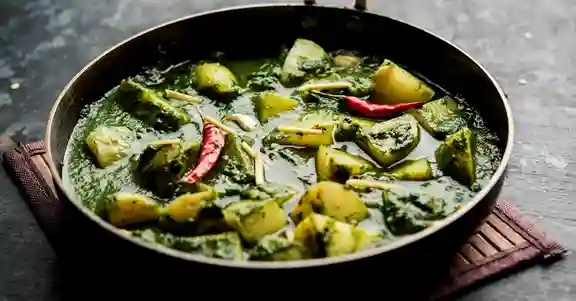
Spinach Potato Curry
Ingredients
- 2 tablespoons oil vegetable or coconut
- 1 teaspoon cumin seeds
- 1 onion finely chopped
- 2 cloves garlic minced
- 1 teaspoon ginger grated
- 2 tomatoes chopped
- 2 medium potatoes peeled and diced
- 4 cups spinach fresh or frozen
- 1 teaspoon turmeric powder
- 1 teaspoon ground cumin
- 1 teaspoon ground coriander
- 1/2 teaspoon chili powder adjust to taste
- Salt to taste
- 1 cup water or as needed
- Fresh cilantro for garnish, optional
Instructions
- Heat the Oil: In a large pan, heat the oil over medium heat.
- Add Spices: Once the oil is hot, add the cumin seeds. Let them sizzle for about 30 seconds.
- Sauté Onions: Add the chopped onions and cook until they turn golden brown.
- Add Garlic and Ginger: Stir in the minced garlic and grated ginger. Cook for another minute until fragrant.
- Cook Tomatoes: Add the chopped tomatoes. Cook until they soften and start to break down, about 5 minutes.
- Add Spices: Mix in the turmeric powder, ground cumin, ground coriander, chili powder, and salt. Cook for another 2 minutes, stirring occasionally.
- Add Potatoes: Add the diced potatoes and mix well to coat them with the spices.
- Add Water: Pour in the water, bring the mixture to a boil, then reduce the heat to low. Cover and simmer for about 15-20 minutes, or until the potatoes are tender.
- Add Spinach: Stir in the spinach. If using fresh spinach, cook until wilted. If using frozen spinach, cook until heated through.
- Adjust Seasoning: Taste and adjust seasoning if necessary.
- Serve: Garnish with fresh cilantro if desired. Serve hot with rice or naan.
